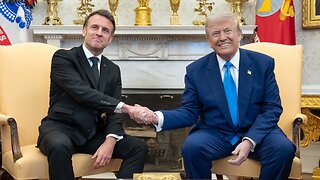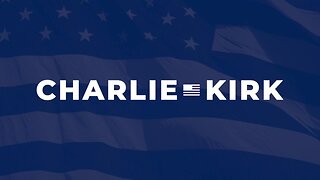Premium Only Content

USAID's Role in Funding Influencers CID
USAID's Role in Funding Canadian Influencers and YouTube’s Involvement in Layering Funds
In recent years, USAID has been indirectly funding Canadian social media influencers who criticize Prime Minister Justin Trudeau and his policies, often pushing narratives that could contribute to civil unrest. This strategy mirrors similar influence operations seen globally, where the U.S. government finances media efforts to shape public opinion in strategic regions. However, in Canada, the approach is more covert, with USAID leveraging YouTube and third-party organizations to distribute funds while maintaining plausible deniability.
How USAID Funds Canadian Influencers
The money does not flow directly from USAID to influencers. Instead, it is layered through a series of intermediaries:
Media Grants and Partnerships
USAID provides grants to media organizations that align with U.S. geopolitical interests.
These organizations then distribute funds to smaller production houses, digital marketing firms, and think tanks that specialize in online influence.
YouTube’s Monetization and Promotional Boosts
YouTube, which has received USAID-backed funding for “countering misinformation” initiatives, plays a key role by ensuring select influencers receive preferential algorithm treatment.
Certain anti-Trudeau channels see increased ad revenue, additional monetization privileges, and recommendations, while others face demonetization and suppression.
YouTube can also indirectly facilitate payments through content sponsorships tied to USAID-funded projects.
NGO and Think Tank Influence
NGOs receiving USAID grants create research reports and media campaigns framing Trudeau’s policies as authoritarian, out-of-touch, or economically disastrous.
These narratives are then funneled to Canadian influencers who present them as grassroots concerns rather than U.S.-backed messaging.
Third-Party Ad Agencies and Consulting Firms
Some digital marketing firms with ties to USAID-run initiatives manage influencer outreach and content production.
These firms act as middlemen, funding influencers under the guise of brand deals, documentary work, or research-driven content.
Targeted Messaging and the Push for Civil Unrest
Influencers receiving this layered funding focus on themes that resonate with discontented Canadians:
Economic Collapse & Housing Crisis: Highlighting rising costs and blaming Trudeau’s government while steering solutions toward U.S.-aligned policies.
Authoritarian Overreach: Portraying Trudeau as a dictator-like figure imposing draconian laws, lockdowns, and censorship.
Election Legitimacy Doubts: Amplifying concerns over electoral integrity and foreign interference to delegitimize future elections.
Protests & Unrest Encouragement: Normalizing civil disobedience and portraying protests as the only viable solution to Trudeau’s leadership.
Why USAID is Interested in Canadian Unrest
The U.S. benefits from a weakened Canada in multiple ways:
Economic Leverage: Instability in Canada pushes skilled workers and businesses southward.
Energy & Resource Control: A disrupted Canadian political landscape can lead to favorable U.S. deals on oil, gas, and other resources.
Geopolitical Alignment: A shift in Canadian politics away from Trudeau’s policies could bring the country closer to U.S. strategic interests.
By using YouTube as a layering mechanism, USAID ensures plausible deniability while steering public discourse in Canada. This operation is an example of modern digital warfare, where influence and narrative control are just as powerful as traditional diplomacy.
-
 LIVE
LIVE
Mike Martins Channel
6 days ago $1.45 earnedBest Of Mike in The Night 24/7 Please Subscribe, Join Our Family
8 watching -
 23:34
23:34
Stephen Gardner
2 hours ago🔥CNN PANICS over $5000 DOGE Dividend | Trump Orders bigger Audits
24.2K66 -
 1:53:54
1:53:54
The White House
4 hours agoPresident Trump Holds a Press Conference with President Emmanuel Macron of France
49K30 -
 1:48:31
1:48:31
The Officer Tatum
4 hours agoLIVE MSNBC DROPS HAMMER On Joy Reid as STAFFERS PANIC! + More Ep 67
67.2K47 -
 59:36
59:36
Chad Prather
3 hours agoTRUMP TAPS DAN BONGINO TO HELP LEAD FBI - IT’S OVER FOR THE DEEP STATE!
54.7K28 -
 4:18:28
4:18:28
Barry Cunningham
9 hours agoTRUMP DAILY BRIEFING: DAN BONGINO TO FBI | LIVE PRESS CONFERENCE WITH MACRON | DOGE MELTDOWN!
50.8K13 -
 2:08:16
2:08:16
Mike Rowe
3 days agoTim Allen Loves The Ballet | The Way I Heard It with Mike Rowe
49.3K17 -
 1:42:25
1:42:25
Russell Brand
8 hours agoWar, Wokeism & Wealth: The Forces Reshaping Our World – SF542
138K91 -
 1:24:13
1:24:13
vivafrei
8 hours agoMadness in Ireland! The War on Women, Children and the Attempt to Silence Whistleblower Jana Lunden!
97.9K57 -
 1:01:41
1:01:41
The Charlie Kirk Show
6 hours agoWhat Did YOU Do This Week? + German Elections | Sen. Scott, Sacks, McCarthy | 2.24.2025
122K47